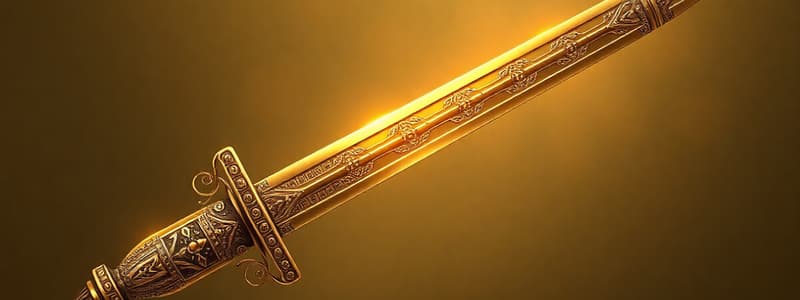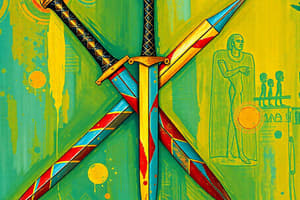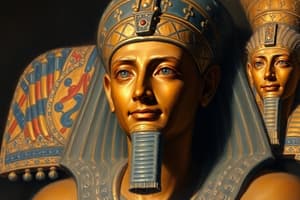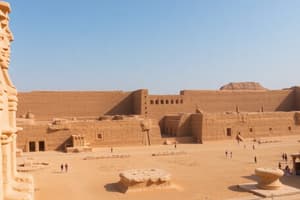Podcast
Questions and Answers
What material was the sword recently discovered in Egypt made of?
What material was the sword recently discovered in Egypt made of?
- Gold
- Iron
- Steel
- Bronze (correct)
What does the presence of Ramses II's insignia on the sword indicate?
What does the presence of Ramses II's insignia on the sword indicate?
- It was used for ceremonial purposes.
- It belonged to a foreign invader.
- It belonged to a prominent military official. (correct)
- It was a common soldier's weapon.
Where was the sword found?
Where was the sword found?
- In the ruins of an ancient temple
- In a mud barrack near Tell Al-Abqain (correct)
- In a commercial trading area
- In a royal tomb
What does Peter Brand suggest about the ancient fort's defense?
What does Peter Brand suggest about the ancient fort's defense?
What kind of items did archeologists discover that offered insights into the soldiers' personal lives?
What kind of items did archeologists discover that offered insights into the soldiers' personal lives?
What does kohl, found among the discovered items, signify about ancient Egyptians' practices?
What does kohl, found among the discovered items, signify about ancient Egyptians' practices?
During which years did Ramses II rule ancient Egypt?
During which years did Ramses II rule ancient Egypt?
Which of the following best describes Ramses II's rule and its impact?
Which of the following best describes Ramses II's rule and its impact?
Flashcards
What is Tell Al-Abqain?
What is Tell Al-Abqain?
A fort built approximately 3,200 years ago located in northwest Egypt. It was a strategic military outpost, likely well-defended, and may have even had an on-site weapons production area.
Who was Ramses II?
Who was Ramses II?
One of the most powerful pharaohs of ancient Egypt, known for his military prowess and architectural accomplishments. His reign saw significant expansion of Egypt's borders, lasting for 66 years, from 1279 to 1213 BCE.
Who was the owner of the bronze sword found at Tell Al-Abqain?
Who was the owner of the bronze sword found at Tell Al-Abqain?
An ancient Egyptian military official, likely a high-ranking officer, who was given the sword bearing the insignia of Ramses II as a royal gift.
What is the bronze sword found at Tell Al-Abqain?
What is the bronze sword found at Tell Al-Abqain?
Signup and view all the flashcards
What is kohl?
What is kohl?
Signup and view all the flashcards
What is the significance of the limestone block with the name "Bay"?
What is the significance of the limestone block with the name "Bay"?
Signup and view all the flashcards
What was kohl used for?
What was kohl used for?
Signup and view all the flashcards
What does the discovery of ovens, storerooms and clay pots with animal bones tell us about the diet of those living at Tell Al-Abqain?
What does the discovery of ovens, storerooms and clay pots with animal bones tell us about the diet of those living at Tell Al-Abqain?
Signup and view all the flashcards
Study Notes
Egyptian Bronze Sword Discovery
- A gleaming bronze sword, inscribed with the insignia of Ramses II, was unearthed in Tell Al-Abqain, Northwest Egypt.
- The sword, dating back over 3,000 years, was found in a small room within a 3,200-year-old military fort.
- The sword's condition suggests it was remarkably well-preserved, retaining its shine.
- The sword's inscription, including the pharaoh's insignia, suggests ownership by a prominent military official.
Ramses II and the Sword
- Peter Brand believes the discovery suggests the fort had an area for weapon production and was strongly fortified.
- The inscription likely served as a status symbol, showcasing Ramses II's generosity, wealth, and authority.
- The significance of the discovery is in understanding the life of a prominent military official during the reign of Ramses II.
Tell Al-Abqain Fort Excavations
- The fort's excavations revealed evidence of daily life, showcasing the self-sufficient nature of the community.
- Storerooms, ovens, pot remains (with evidence of fish and animal bones), and personal items like bead necklaces and kohl applicators were discovered.
- The evidence suggests a diverse diet within the community.
- Kohl's purpose, eye protection, highlights the daily needs and the social lives of people living in this era.
Ramses II: Background Information
- Ramses II, also known as Ramses the Great, was a significant pharaoh.
- He ruled Egypt during the 19th Dynasty, from 1279 BCE to 1213 BCE, reigning for 66 years.
- He was the second longest-reigning pharaoh in ancient Egypt's history.
- Renowned for military leadership, Ramses II significantly expanded Egypt's borders east to Syria and south to Sudan.
- Also known as a "builder pharaoh", he commissioned numerous temples and monuments during his reign.
Studying That Suits You
Use AI to generate personalized quizzes and flashcards to suit your learning preferences.





